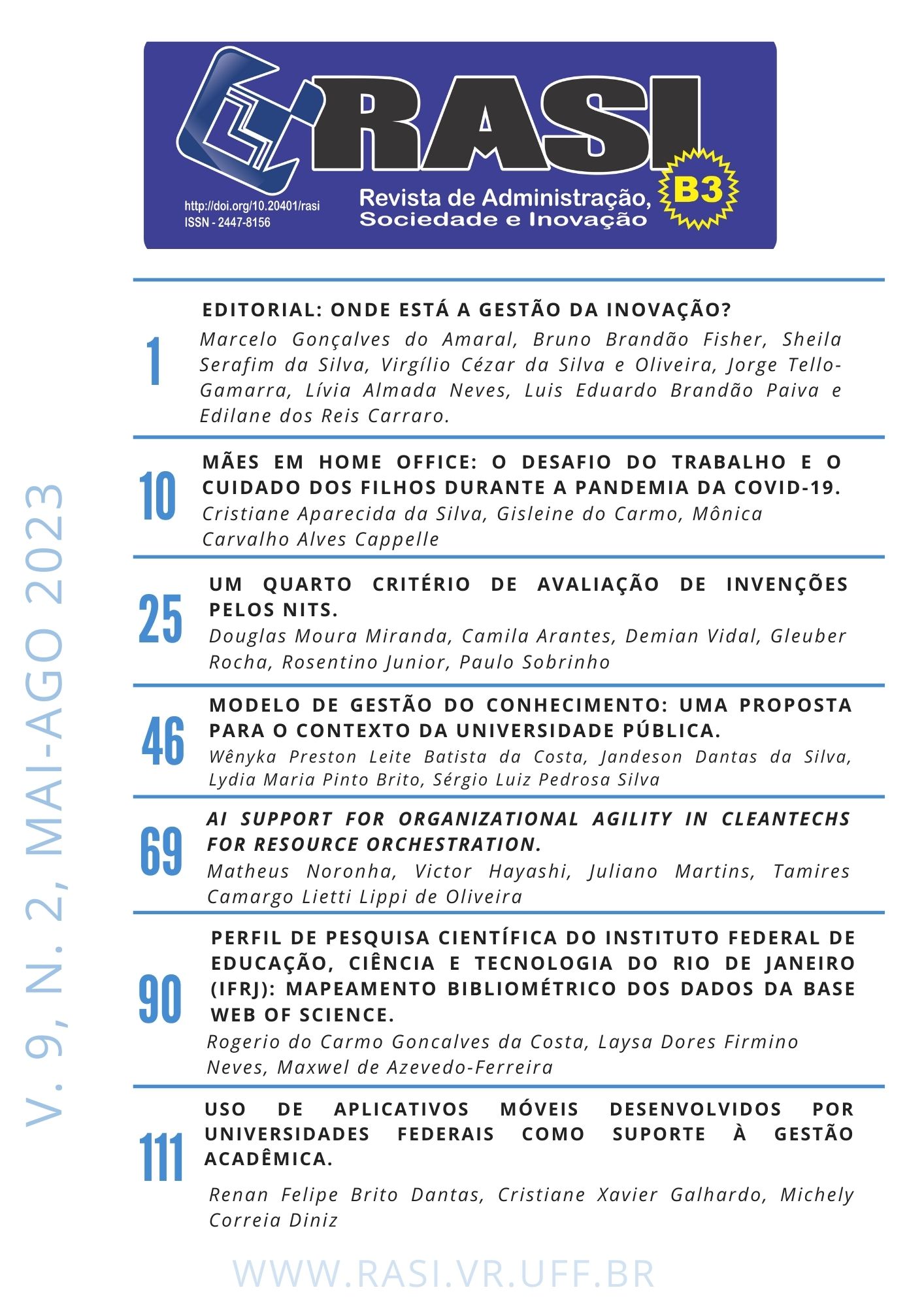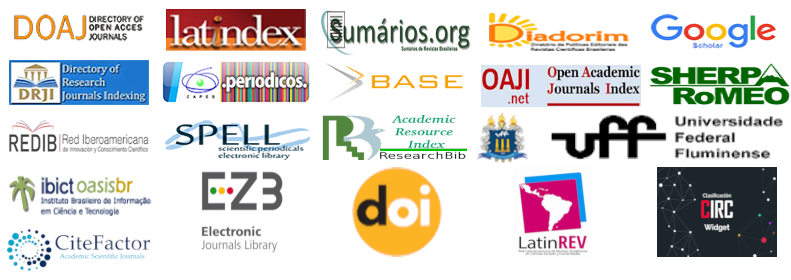AI Supports Cleantechs' Organizational Agility and Resource Orchestration
DOI:
https://doi.org/10.20401/rasi.9.2.733Palavras-chave:
Inteligência Artificial, Agilidade Organizacional, Orquestração de Recursos, Cleantechs, Objetivos de Desenvolvimento SustentávelResumo
The business environment approaches the use of technologies to broaden its range of competitiveness in the market. Studies demonstrate through Artificial Intelligence new competitive paths and how these can orchestrate technologically sustainable resources. This paper aims to present a proposition model that identifies how Artificial Intelligence (AI) enhances Organizational Agility (OA) for Resource Orchestration (RO) in the context of clean technology companies and sustainable development goals (SDGs). A qualitative, multiple case study research was conducted with 22 semi-structured interviews from 17 clean technology companies in the areas of renewable energy, energy commercialization, energy efficiency, sanitation, and water treatment. Content analysis was used to analyze the data. AI encourages AO to OR, also pointing out new categories (findings) such as: Technology and Digital Skills, System Dynamics, and Accuracy for developing innovative products and services in Cleantechs. This study contributes to the literature with a new model of AI and OA, Orchestrating Resources through Digital and Technology Competencies, providing Dynamics between Learning Systems and Accuracy for the development of products and services that aim to collaborate with the SDGs. Illustrate the strategic paths that Artificial Intelligence can take from the perspective of Machine Learning to address solutions for the energy and sanitation sectors, providing innovations. The originality of the work lies in the contextual articulation of the work between AI, AO and OR in the context of clean tech companies and SDGs.
Downloads
Referências
Ahuja, S., & Chan, Y. E. (2017). Resource orchestration for IT-enabled innovation. Kindai management review, 5(1), 78-96.
Carnes, C. M, Hitt, M. A., & Xu, K.,(2016). Resource based theory in operations management research. Journal of Operations Management, 41, 77-94.
Carnes, C. M., Chirico, F., Hitt, M. A., Huh, D. W., & Pisano, V. (2017). Resource orchestration for innovation: Structuring and bundling resources in growth-and maturity-stage firms. Long range planning, 50(4), 472-486.
Delmestri, G., Montanari, F., & Usai, A. (2005). Reputation and Strength of Ties in Predicting Commercial Success and Artistic Merit of Independents in the Italian Feature Film Industry*. Journal of Management Studies, 42(5), 975–1002. http://doi.org/10.1111/j.1467- 6486.2005.00529.x
Dierickx, I., & Cool, K. (1989). Asset Stock Accumulation and Sustainability of Competitive Advantage. Management Science, 35(12), 1504–1511.
Dove, R. (1994). Tools for analyzing and constructing agility. In Proceedings of the Third Annual Agility Forum Conference/Workshop, Austin, TX
Faceli, K., Lorena, A. C., Gama, J., & de Carvalho, A. (2011). Inteligência Artificial: Uma abordagem de aprendizagem de máquina (1st ed.; LTC, Ed.). Rio de Janeiro: Grupo Editorial Nacional.
FGV -Fundação Getúlio Vargas: Centro de Estudos em Sustentabilidade. Mapeamento do Ecossistema de Startups Cleantechs no Brasil. 2019. Disponível em: Acesso em 29 de Janeiro de 2022.
Gustafsson, J. (2017). Single case studies vs. multiple case studies: A comparative study.
Harraf, A., Wanasika, I., Tate, K., & Talbott, K. (2015). Organizational Agility. Journal of Applied Business Research (JABR), 31(2), 675–686.
Joshi, K.D., Chi, L., Datta, A. and Han, S. (2010). “Changing the Competitive Landscape: Continuous Innovation through IT-Enabled Knowledge Capabilities”, Information Systems Research, Vol 21, No. 3, pp 472–495
Mio, C., Panfilo, S., & Blundo, B. (2020). Sustainable development goals and the strategic role of business: A systematic literature review. Business Strategy and the Environment, 29(8)
Nascimento, L. de C. N., Souza, T. V. de, Oliveira, I. C. dos S., & Moraes, J. R. M. M. de. (2018). Theoretical saturation in qualitative research: an experience report in interview with schoolchildren. Revista Brasileira de Enfermagem, 71(1), 228–233.
Panda, S., & Rath, S. K. (2017). The effect of human IT capability on organizational agility: an empirical analysis. Management Research Review, 40(7), 800–820.
Pernick, R., & Wilder, C. (2007). The clean tech revolution: The next big growth and investment opportunity. Harper Collins.
Peuscher, D. W. (2016). The resource orchestration theory as contributor to supply chain management: An assessment on its applicability (Bachelor's thesis, University of Twente).
Rangel-Martinez, D., Nigam, K. D. P., & Ricardez-Sandoval, L. A. (2021). Machine learning on sustainable energy: A review and outlook on renewable energy systems, catalysis, smart grid and energy storage. Chemical Engineering Research and Design, 174, 414-441.
Ravichandran, T. (2018). Exploring the relationships between IT competence, innovation capacity and organizational agility. The Journal of Strategic Information Systems, 27(1),
Shakeel, S. R. (2021). Cleantech: Prospects and Challenges. Journal of Innovation Management, 9(2), VIII-XVII
Shukla, P. (2015). Structuring, Bundling but Leveraging? Impact of Performance on Resource Management. Impact of Performance on Resource Management (September 1, 2015).
Sirmon, D. G., Hitt, M. A., & Ireland, R. D. (2007). Managing Firm Resources in Dynamic Environments to Create Value: Looking Inside the Black Box. Academy of Management Review, 32(1), 273–292. http://doi.org/10.5465/AMR.2007.23466005
Trinh, T. P., Molla, A., & Peszynski, K. (2012). Enterprise Systems and Organizational Agility: A Review of the Literature and Conceptual Framework. Communications of the Association for Information Systems, 31
Wang, G., Li, L., & Jiang, X. (2019). Entrepreneurial business ties and new venture growth: The mediating role of resource acquiring, bundling and leveraging. Sustainability, 11(1), 244.
Wang, H., Huang, J., & Zhang, Z. (2019). Association for Information Systems Electronic Library (AISeL): The Impact of Deep Learning on Organizational Agility.
Yin, R. K. (2009). How to do better case studies. The SAGE handbook of applied social research methods, 2, 254-282. https://doi.org/10.4135/9781483348858.n8
Zainal, A. Y., & Zainal, H. Y. (2020). Dimensions of Agility Capabilities Organizational Competitiveness in Sustaining. Proceedings of the International Conference on Artificial Intelligence and Computer Vision (AICV2020).
Zitkiene, R., & Deksnys, M. (2018). Organizational Agility Conceptual Model. Montenegrin Journal of Economics, 14(2), 115–129.
Downloads
Publicado
Versões
- 2023-05-08 (2)
- 2023-05-01 (1)
Edição
Seção
Licença
Copyright (c) 2023 Revista de Administração, Sociedade e Inovação

Este trabalho está licenciado sob uma licença Creative Commons Attribution 4.0 International License.
A RASI, de acordo com a Lei nº 9.610, de 19.02.98 que altera, atualiza e consolida a legislação sobre direitos autorais e dá outras providências, adota as seguintes condições da Cessão de Direitos Autorais:
- A Revista de Administração Sociedade e Inovação (RASI) mantém, com a cessão dos direitos autorais, a posse dos direitos sobre os conteúdos por ela publicados;
- O autor retém seus direitos morais do conteúdo, incluindo o direito de ser identificado como autor sempre que o conteúdo for publicado;
- Apesar da atribuição dos direitos autorais o autor retém o direito de reutilizar o material em coleções futuras de seu próprio trabalho sem ônus. Os reconhecimentos da publicação anterior na RASI são as únicas exigências em tais casos;
- O autor pode fazer fotocópias do conteúdo, ou distribuí-lo por meio de correio eletrônico ou fax, desde que destinadas às suas próprias aulas e com finalidade de atender objetivos de pesquisa, sob a condição de que: (a) tais cópias não sejam revendidas e (b) referência a fonte original da publicação e o nome da RASI estejam indicados claramente em todas as cópias feitas do material.











